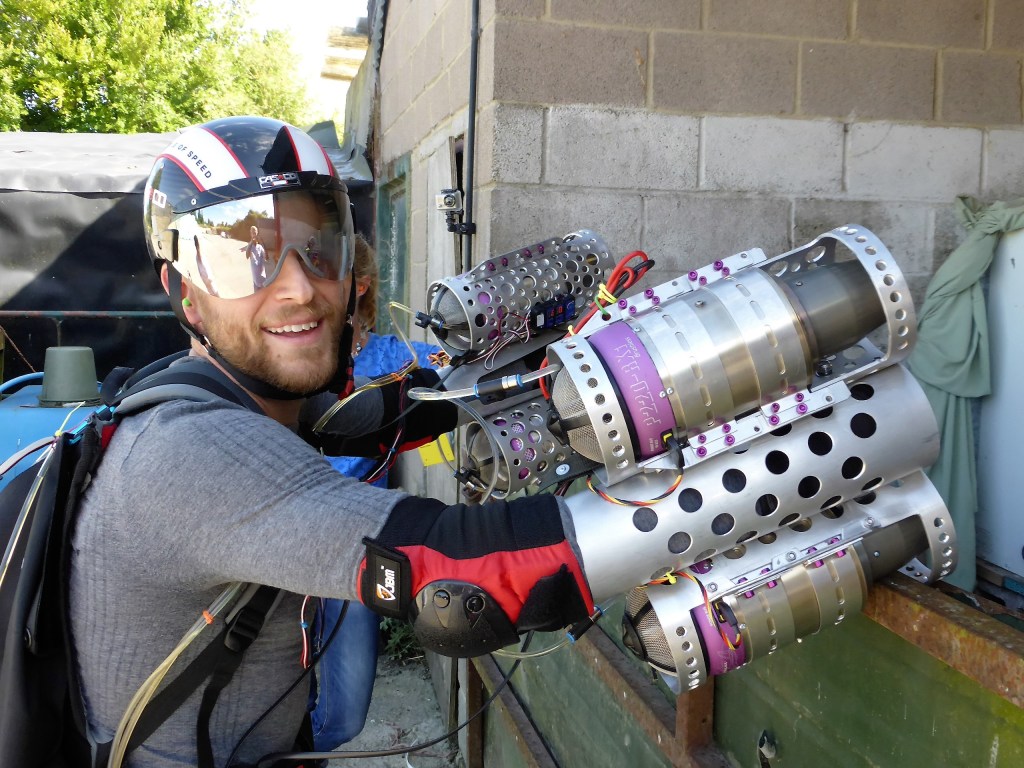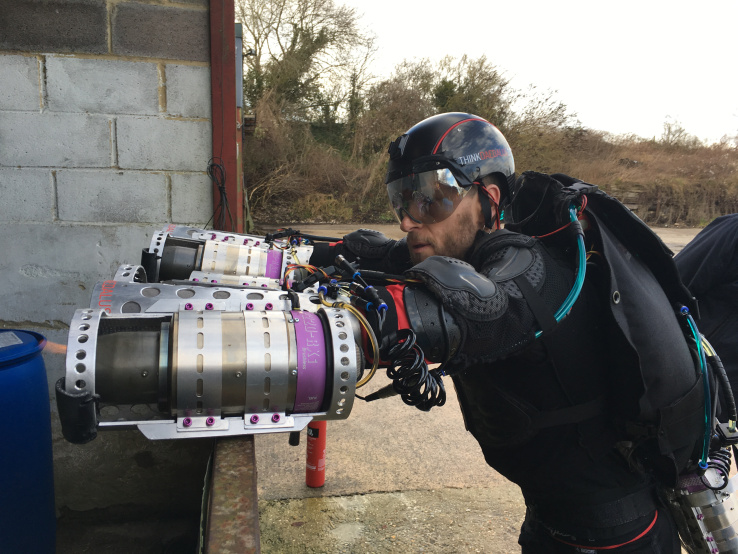A YouTube collection of grainy video clips highlights the progress Gravity founder Richard Browning has made toward his outlandish dream over the past year. Each seems more terrifying than the last, with multiple jet engines attached to his limbs in various configurations, as he hovers a few feet from the ground.
The press material attached to the announcement heralds the oil trader turned entrepreneur as a real life Iron Man, but it’s hard to shake the feeling that you’re watching some sort of backyard mad scientist, a few moments away from the world’s most dangerous Jack Ass stunt. Browning acknowledges how downright alarming the footage of the Daedelus rig appears, but shakes off any notion that he’s actually in danger at any point during the three-and-a-half minute package.
“I can just strap this thing on and go flying at a moment’s notice,” he told TechCrunch in a phone interview this week. “It’s less dangerous than riding a sports bike through the countryside.” Browning rattles off a list of safety precautions with the excitement of a child attempting to convince a parent about the safety of some ill-advised new toy. He adds that he has yet to injure himself during operation.
The top speed of the current configuration isn’t any faster than a human running pace, Browning explains, and the aviation fuel was chosen specifically for its non-explosive qualities. The craft never hovers more than a few meters above the ground by design and there’s an unfortunately named dead man’s switch he has to keep pressed at all times to continue operation.

“If I fell in some imaginably bad way and somehow burst my robust fuel system, I would just leak it very slowly on the floor,” he explains. “If I spent a lot of effort trying to somehow ignite that and it finally caught fire, I’ve got a fireproof suit underneath my kit and I’m never more than 30 feet from two people with fire extinguishers. So actually, it’s really quite lame in that sense, which was done deliberately. It’s no way as dangerous or crazy as it looks.“
It is, however, quite the spectacle. Even in stealth mode, the company has managed to attract the interest of investors and partners like Red Bull, which has been documenting Browning’s journey with far more stylized video of his early attempts. The rig’s inventor insists that he never had commercial ambitions for the Daedelus, that the flight suit was only intended to answer the question of “what if?”
Browning funded the project himself for the first nine months of its gestation, taking it from his initial conception of a flapping drone — only to have his thunder stolen by similar ongoing research at Oxford University — to something more akin to its current configuration.
“We pivoted the idea,” he explains. “We stuck with the idea of the human mind and body as being the core of it, but added in a little bit of horsepower. We played around with electric drone fans, but the power to weight ratio isn’t there, so we went to gas turbines.”
In its near final form, the suit offers a new take on the traditional jet-pack idea, offering the user more degrees of control and a potentially more natural interface by transferring mobility to the limbs. Browning likens it to riding a bike. “If you let go,” he says, “your brain does the rest.”
Of course, the rig’s got plenty of trials ahead of it. And for the time being, the only application that Browning anticipates for the Daedelus is sheer visual spectacle. Recreation use could be somewhere down the line for thrill seekers with $200,000 to burn on a suit. And maybe somewhere off in the distance, it has the potential to help EVAC teams navigate difficult to reach locales. For now, however, it’s just about the show.
And as for the name, Browning admits that “Daedelus” can use a bit of work, both with regards to its unpronouncability and the popular Greek myth tied to the name. “I’m going to blame my eight-year-old [son],” says Browning. Most of the Greek heroes have something lurking in the closet. But Daedelus, so my son tells me, was a renowned craftsman and innovator.”

But Daedelus’ best known story involves letting his son Icarus fly too close to the sun. It’s a tough metaphor to shake off for an inventor who is strapping a bunch of jet engines to his limbs. But Browning is unperturbed. Sure, the company is planning to give the next model a more straightforward title, but the entrepreneur laughs off the Icarus comparisons. In fact, he’s even working on a miniature version for his kids that trades the jet engines for something less aggressive.
“We’re messing around and seeing if we can adapt a couple of drone fans,” he says. “We’re going to mock up something for my boys, so they’ve got a sort of quiet, cold version of the same thing that they can leap around with.”














